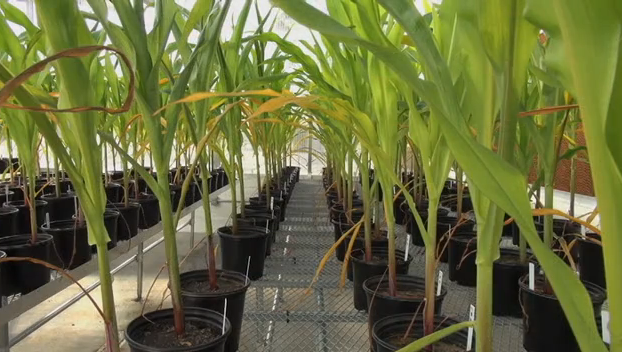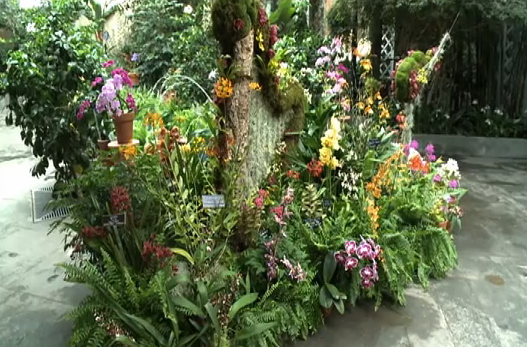VOA慢速英语:农业上的下一个大事件可能很"小"
From VOA Learning English, this is Science in the News.
I’m Anna Matteo.
And I’m Christopher Cruise.
Today we tell how some extremely small organisms may help meet our foodneeds in the future. Then, we report on an American project to saveendangered orchids. Finally, we tell about the discovery of what Britishscientists are calling the oldest human footprints found outside of Africa.
Small Organisms May Help Meet Food Needs of the Future
Experts say farmers will need to produce about 70 percent more food by themiddle of the century. They predict that nine billion people will need to be fedworldwide by 2050.
The prediction means experts will need to develop more-effective farmingmethods that cause less harm to the environment. Experts say living thingscalled “microbes” could help meet that need. A microbe is an organism sosmall it can be seen only with a microscope.
Jeff Dangl is a biology professor at the University of North Carolina. He saysresearchers are finding extremely small organisms in the ground.
“This soil was teeming with life.”
Jeff Dangl says one gram of soil contains between 100 million and one billionmicrobes.
He says microbes are taking part in a healthy exchange with the plants thatshare the soil. Around plant roots, microbes change chemicals in the air andsoil into food for the plants. The microbes include bacteria and material knownas “fungi.”
Some microbes act as bodyguards. They produce anti-bodies and otherchemicals to fight harmful germs.
 |
Plants make sugar through a process called “photosynthesis.” This happenswhen a plant receiving light changes water and carbon dioxide into food.
Professor Dangl says much of the sugar is pumped down through the roots.There, it is turned into sugar-based microbe food and released into the soil. He says that is done to get microbes to help the plants grow better. Some of the organisms turn chemicals in the air and soil into food that the plants caneat.
The microbes produce antibiotics and other chemicals to fight the harmfulgerms. Professor Dangl said bacterial and fungal parts of the plant organismmust be considered to understand how plant organisms operate.
The biosciences company Novozymes already sells one kind of fungi thathelps plants get phosphorous from the soil.
Shawn Semones is the head of product research for the company. At anexperimental greenhouse in Virginia, he is treating the roots of corn plants witha microscopic fungus.
He holds a small plastic cup which has a dead insect inside. The insect isdeveloping a fine white coat of mold -- a substance that grows on livingorganisms. That mold killed the insect. The white covering is producingspores that will blow in the wind to infect another insect.
Shawn Semones says the microbe develops naturally. He says Novozymeshas found a way to produce it in very large amounts and offer it to farmers as a bio-pesticide. A bio-pesticide protects crops from animals, microbes,bacteria and fungi.
Novozymes recently signed a $300 million deal with Monsanto, a companybest known for producing seeds and chemicals. The goal is to help bringdiscoveries about microbes to farmers’ fields.
You are listening to the VOA Learning English program Science in the News. With Christopher Cruise, I’m Anna Matteo in Washington.
Project to Save Endangered Orchids Growing in Florida
Our planet is home to 20,000 kinds of orchids. Orchids exist on almost everycontinent. But the beautiful and valuable flowers live mainly in warm, moistclimates like that found in the southern part of Florida.
America’s “sunshine state” has about 50 native species of orchid. But manyare in danger of dying out. This threat has led scientists to launch a five-yearproject to save them.
Carl Lewis directs Miami’s Fairchild Tropical Botanical Garden. He says manyorchid species native to Florida have become rare.
“Most of those orchids are very difficult to find now. They’ve, they’ve beenhunted almost to extinction in the wild. So, really, we launched this project justas an effort to bring those orchids back.”
The project to grow and plant one million orchid seedlings began two yearsago. Orchids grow mostly on trees. But their seedlings are extremely small,delicate and weak. So they start their life in a laboratory.
The seeds grow in clean bottles with required nutrients. After that, the youngplants are moved to a warming device with LED lights. Next, they go to anursery -- an area where plants are grown. Two years may pass before theplants are strong enough to be connected to -- or fixed onto -- trees.
Volunteers help Carl Lewis to transplant -- or move -- the orchid plants. Hesays it is important to transplant enough older orchids so they can continue toreproduce without that help.
“This is supposed to be an infusion, just to get so many out there that theystart to reproduce on their own.”
After these plants are moved to areas where other orchids grow, scientistshope insects and tiny organisms will find the orchids.
The campaign to save native orchids also depends on help from localstudents. They have been asked to watch the transplanted orchids in theirneighborhoods. A number of plants will also be given away to try to reduce thechance that people will steal them off the trees.
The Center for Plant Conservation guides the conservation and study ofthreatened plants across the United States. The center is based in the city ofSt. Louis, Missouri.
Britain’s Oldest Human Footprints Found on Coastline
Finally, British scientists have found what they believe are the oldest humanfootprints ever discovered outside of Africa. The footprints of what appears to be ancient humans were found in the seaside community of Norfolk, ineastern Britain. The scientists estimate the markings are between 800,000 and almost one million years old. They may be about 500,000 years older thanthe earliest footprints ever found in the country. If so, that could provide theoldest evidence of human beings in northern Europe.
Images and a model of one of the footprints were recently shown to reportersat the British Museum in London. A team of scientists found the footprints inMay, 2013. The scientists work for the British Museum, Britain’s NaturalHistory Museum, and Queen Mary University of London. The researchers sayocean water from incoming tidal waves made it impossible to remove theprints from the coast.
The area appears to have 50 footprints of both adults and children. They werefound near the village of Happisburg. The British Museum says theHappisburg area has what it calls a “remarkable concentration” of early StoneAge archeological sites. All were found since 2000.
Archeologist Nick Ashton described how he felt when he recognized thefootprints came from prehistoric humans. At the time, he was looking at e-mails on his computer.
 |
“It was only when the, this overhead views e-mailed through to me back in myoffice I suddenly looked at it and opened up the file and I thought, ‘This isabsolutely amazing, you know -- there, there is no doubt this is really is humanfootprints.”
He says the discovery will change the understanding of early human history inEurope.
The researchers estimate the height of the early humans at between about.93 and 1.73 meters. The difference in the heights suggests a group of mixedages.
Isabelle de Groote is with Liverpool John Moores University in the city ofLiverpool. She examined the footprints. She says the markings help to tellabout the humans who may have made them.
“The spread of the footprint size gives us an indication that we have children, a number of children and then probably some adults there with at least one,you know with probably one, male.”
One footprint appears to show the mark of toes.
Scientists say Britain was joined to continental Europe about a million yearsago. It is not known how the early humans survived in the cold climate ofnorthern Europe. Scientists believe the creatures who left the footprints wererelated to Pioneer Man, an ancestor of Homo sapiens. Pioneer Man wasknown to have lived in a warmer climate.
Researchers continue looking for human fossil remains in the Happisburgarea. A report on the footprint discovery and its meaning was published in thejournal PLOS ONE.
This Science in the News was written by Jerilyn Watson. It was based onstories from VOA reporters Steve Baragona and George Putic. ChristopherCruise produced the program.
I’m Anna Matteo.
And I’m Christopher Cruise.
To comment on this program, go to our website,learningenglish.voanews.com. While you are there, you can read, listen to anddownload our programs. You can follow us on Facebook, iTunes, LinkedIn,Twitter and on our YouTube Channel, all at VOA Learning English.
Join us again next week for more news about science on the Voice ofAmerica!
- 频道推荐
- |
- 全站推荐
- 推荐下载
- 网站推荐




















